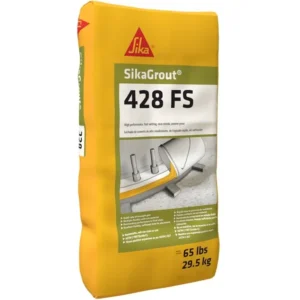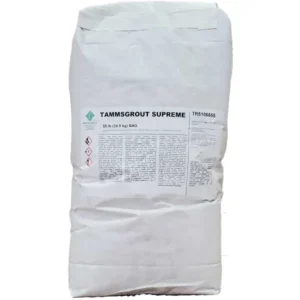High Strength
High strength cement grouts deliver impressive compressive strengths between 10,000 and 14,000 psi, making them the go-to choice for heavy-duty construction and industrial projects. These specialized grouts excel where standard products fall short — think heavy machinery bases, anchor bolts, structural columns, and equipment foundations that face serious loads and constant vibration. What makes them special? It’s all in the mix: premium aggregates, high-performance binders, and special additives that create a grout that flows easily into tight spaces, won’t shrink over time, and reaches full strength quickly to get your project back online. From power plants and bridges to manufacturing facilities, high strength grouts provide the rock-solid foundation you need when failure simply isn’t an option. They’re tough enough to handle not just heavy loads, but also vibration, chemicals, and temperature swings — giving you one less thing to worry about on critical installations.
Showing all 10 results
Showing all 10 results
Understanding High Strength Cement Grout
High strength cement grout is a specialized cementitious material engineered to achieve compressive strengths between 10,000 and 14,000 psi, significantly exceeding the performance of conventional grouts. This advanced construction material consists of Portland cement, carefully graded fine aggregates, and proprietary admixtures that work together to create a flowable, non-shrink mixture capable of supporting extreme loads and withstanding demanding environmental conditions.
What Makes High Strength Cement Grout Different
The key differentiator of high strength cement grout lies in its sophisticated formulation. While standard grouts typically achieve strengths of up to 10,000 psi, high strength varieties incorporate specialized components including supplementary cementitious materials, high-range water reducers, and shrinkage-compensating additives that fundamentally alter the material’s microstructure. This results in a denser, more durable matrix with superior load-bearing capacity and enhanced resistance to chemical attack, freeze-thaw cycles, and dynamic loading.
The precision-engineered particle size distribution and optimized water-to-cement ratio create a material that flows easily during placement yet develops exceptional strength as it cures. This combination of workability and performance makes high strength grout ideal for critical structural applications where both ease of installation and long-term reliability are essential.
How High Strength Cement Grout Works
When mixed with water, high strength cement grout undergoes a controlled hydration process that forms an exceptionally dense crystalline structure. The material’s flowable consistency allows it to penetrate tight spaces and completely fill voids beneath base plates, ensuring full contact and optimal load transfer. As it cures, the grout typically exhibits controlled expansion or zero shrinkage, maintaining intimate contact with surrounding surfaces and preventing the formation of gaps that could compromise structural integrity.
Common Applications for High Strength Cement Grout
High strength cement grouts serve critical roles across numerous industrial and infrastructure applications. In heavy manufacturing facilities, these grouts secure production equipment including stamping presses, injection molding machines, and CNC machining centers where precision alignment and vibration resistance are paramount. Power generation facilities rely on high strength grouts for turbine foundations, generator bases, and auxiliary equipment supports that must withstand continuous operation and thermal cycling.
The transportation infrastructure sector utilizes high strength cement grouts for bridge bearing pads, post-tensioning anchor zones, and precast concrete connections where load transfer efficiency directly impacts structural integrity. In the petrochemical industry, these materials provide reliable support for compressors, pumps, and processing equipment operating under extreme conditions. Mining and aggregate operations depend on high strength grouts for crusher foundations, conveyor supports, and screening equipment bases subjected to constant impact and vibration.
Marine and port facilities represent another significant application area, where high strength grouts secure crane rails, bollards, and equipment exposed to saltwater and cyclic loading. Wind turbine foundations, both onshore and offshore, increasingly specify high strength grouts for their critical base connections where fatigue resistance and durability are essential for the structure’s 20+ year design life.
Installation Methods and Best Practices
Proper installation of high strength cement grout requires careful surface preparation, precise mixing, and controlled placement techniques. The substrate must be clean, sound, and saturated surface-dry (SSD) to prevent premature moisture loss from the grout. All oil, grease, laitance, and loose material must be removed through mechanical preparation such as shot blasting or high-pressure water jetting. Formwork should be liquid-tight and capable of withstanding the hydraulic pressure generated during placement.
Mixing procedures are critical to achieving specified performance. Most high strength grouts require mechanical mixing with a drill and paddle or mortar mixer—hand mixing is generally not recommended. The manufacturer’s specified water content must be carefully measured and not exceeded, as excess water will reduce strength and increase shrinkage. Many high strength grouts utilize flowable or self-leveling properties that allow placement via pumping, pouring, or dry-pack methods depending on the specific application requirements.
Temperature considerations play a crucial role in achieving optimal performance. Cold weather installations may require heated mixing water, heated aggregates, and thermal protection during curing, while hot weather applications benefit from cool mixing water and measures to prevent rapid moisture loss. Most high strength grouts achieve substantial strength within 1 to 3 days, reaching approximately 70-80% of their 28-day strength within the first week, though full design strength typically develops over 28 days.
Key Performance Characteristics
High strength cement grouts offer numerous performance advantages that justify their selection for critical applications. The exceptional compressive strength (10,000-14,000 psi) provides superior load distribution and eliminates the risk of crushing under heavy machinery. These materials typically achieve 5,000+ psi in just 24 hours and 8,000+ psi within 3 days, allowing for rapid equipment installation and commissioning.
Non-shrink properties represent a fundamental characteristic of quality high strength grouts. Through controlled expansion or shrinkage compensation, these materials maintain positive contact with base plates and surrounding concrete throughout the curing process and service life. This dimensional stability prevents the formation of voids that could compromise load transfer or allow moisture infiltration.
Additional performance benefits include:
- High early strength for fast-track construction schedules
- Excellent flowability ensuring complete filling of complex spaces
- Superior bond strength to concrete and steel surfaces
- Low permeability protecting against moisture and chemical intrusion
- Vibration damping properties for dynamic equipment
- Fatigue resistance under cyclic loading conditions
- Wide temperature tolerance for various climates and conditions
Selecting the Right High Strength Cement Grout
Choosing the appropriate high strength cement grout requires careful evaluation of project-specific requirements:
Strength Requirements: Determine the minimum compressive strength needed based on loading conditions, with appropriate safety factors. Consider both early strength requirements for rapid commissioning and ultimate strength for long-term performance.
Flow Characteristics: Assess placement constraints including gap thickness, distance to flow, and accessibility. Some applications require fluid consistency for pumping long distances, while others need stiffer dry-pack consistency for vertical or overhead work.
Environmental Conditions: Consider exposure to chemicals, temperature extremes, freeze-thaw cycles, or marine environments. Special formulations offer enhanced resistance to sulfates, chlorides, or other aggressive conditions.
Working Time: Balance the need for adequate placement time with strength gain requirements. Extended working time formulations allow for large pours, while rapid-setting varieties minimize equipment downtime.
Clearance Requirements: Verify the minimum and maximum placement thickness capabilities of the grout, as some products are optimized for thin sections while others accommodate deep pours.
Quality Control and Testing Standards
Ensuring the performance of high strength cement grout installations requires adherence to established testing standards and quality control procedures. Pre-placement testing should verify compliance with ASTM C1107 (Standard Specification for Packaged Dry, Hydraulic-Cement Grout) for non-shrink properties and strength development.
Field quality control measures include:
- Flow testing using ASTM C1437 flow cone method to verify consistency
- Temperature monitoring of grout, substrate, and ambient conditions
- Test cube preparation following ASTM C942 for compressive strength verification
- Volume change testing per ASTM C1090 to confirm non-shrink properties
Post-installation evaluation may include non-destructive testing to detect voids or inadequate consolidation. For critical applications, pull-out testing can verify bond strength development between the grout and substrate. Documentation of mixing procedures, placement conditions, and test results provides essential records for warranty and maintenance purposes.
Economic Considerations
While high strength cement grouts command premium prices compared to standard grouts, their superior performance characteristics often result in lower total lifecycle costs. The enhanced durability reduces maintenance requirements and extends service intervals, minimizing operational disruptions. The ability to support heavier loads with smaller bearing areas can reduce foundation sizes and associated construction costs.
Faster strength gain properties enable quicker equipment installation and startup, reducing project schedules and associated costs. The reliability provided by high strength grouts in critical applications helps prevent catastrophic failures that could result in equipment damage, production losses, or safety incidents far exceeding the initial material cost differential.
Future Developments in High Strength Cement Grout Technology
The evolution of high strength cement grout continues as manufacturers develop increasingly sophisticated formulations. Advanced admixture technology promises enhanced performance through improved plasticizers and strength-enhancing additives. Research into ultra-high-performance formulations aims to push compressive strengths even higher while maintaining workability and non-shrink properties.
Sustainable formulations incorporating recycled materials and alternative cementitious materials aim to reduce the environmental footprint while maintaining performance. Extended working time formulations provide greater flexibility for large or complex pours, while rapid-strength varieties continue to reduce equipment downtime for critical repairs.
As infrastructure demands grow and industrial equipment becomes more sophisticated, high strength cement grouts will continue playing an essential role in providing reliable, long-lasting foundations for critical applications. Understanding their properties, applications, and proper implementation ensures successful projects that meet both immediate needs and long-term performance expectations.









